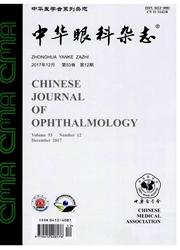

 中文摘要:
中文摘要:
目的探讨外直肌完全麻痹斜视患者的术式选择、影响因素及疗效评价。方法回顾性系列病例研究。收集2009年5月至2011年5月在复旦大学附属眼耳鼻喉科医院行加强的部分直肌转位术治疗外直肌完全麻痹的内斜患者共28例(31只眼),对术前及术后眼位、代偿头位、复视、双眼单视注视野以及眼球运动等进行比较分析。对术前及术后双眼单视注视野,麻痹眼的运动情况进行配对t检验。结果依据牵拉实验以及术前术后检查结果,28例患者(31只眼)中,8只眼行单纯直肌转位术,10只眼行麻痹肌的拮抗肌后退术及直肌转位术,7只眼行直肌转位术及对侧眼配偶肌后退术,6只眼行直肌转位术、对侧眼配偶肌后退术及麻痹肌的拮抗肌后退术。术后3-8个月(平均5个月),28例患者中术后第一眼位完全正位者17例,其余患者均轻度欠矫在10△以内。27例术前有复视及代偿头位的患者中,26例术后第一眼位复视及代偿头位消失,1例双眼外直肌完全麻痹患者,术后残余10°,第一眼位主诉仍有复视并伴轻度代偿头位,予配戴三棱镜矫正,患者复视及代偿头位消失。所有患者双眼注视野从术前的27.0°±6.4°扩大到术后的40.5°±4.8°(t=-34.692,P〈0.001),受累眼的眼球运动从术前的-4.9±0.4增加到术后的-2.9±0.9(t=-13.418,P〈0.001)。结论加强的部分直肌转位术能安全有效地改善外直肌完全麻痹内斜患者的第一眼位,消除患者异常头位以及第一眼位的复视,提高受累眼眼球运动能力,显著扩大患者双眼单视范围。在确定手术方式和术式的先后顺序时,麻痹肌的拮抗肌的被动牵拉实验是一个关键因素。
 英文摘要:
英文摘要:
Objective To investigate surgical approach for paralytic strabismus with lateral rectus muscles paralysis and evaluate its clinical effects. Methods Design retrospective, observational case series. 28 patients (31 eyes) who underwent augmented partial rectus muscle transposition (APRMT) in the treatment of paralytic strabismus with lateral rectus muscles paralysis from May 2009 to May 2011 at Eye&ENT Hospital of Fudan University were included in this study. The following data were analyzed : ( 1 ) The procedure that was performed, (2) The angle of deviation of primary position, (3) The presence of compensatory head posture, (4) The presence of diploma in the primary position, (5) The binocular single visual fields, ( 6 ) The motility of the affected eye. Results According to the results of rectus muscle forced traction test and examination before and after operation, among 31 eyes in 28 patients, 8 eyes were treated with APRMT, 10 eyes were treated with reeession of antagonistic muscle of paralytic rectus muscle combined with APRMT, 7 eyes were treated with APRMT and recession of yoke musele, 6 eyes were treated with APRMT and recession of yoke muscle combined with recession of antagonistic muscle. 17 among 28 patients were orthotropia in the primary position while others were in mild undercorrection with deviation no more than10 prism degrees during 5 months (range: 3-8 months) follow-up in average. The diploma and abnormal head posture were eliminated in 26 patients except one patient who was appeared with 10 prism degrees undereorrection postoperatively arid was resolved by wearing prisms thereafter. Binocular single visual fields were exteaded from 27.0°± 6.4° preoperatively to 40.5°± 4. 8° postoperatively ( t = - 34. 692, P 〈 0.001). Ocular movement was improved from -4.9 ± 0.4 to - 2.9±0.9 postoperatively (t = -13.418, P 〈 0. 001 ). Conclusions APRMT can safely and effectively correct the primary position in paralytic strabismus with lateral rec
 同期刊论文项目
同期刊论文项目
 同项目期刊论文
同项目期刊论文
 Myopia induced by flickering light in guinea pigs: a detailed assessment on susceptibility of differ
Myopia induced by flickering light in guinea pigs: a detailed assessment on susceptibility of differ Effects of the chromatic defocus caused by interchange of two monochromatic lights on refraction and
Effects of the chromatic defocus caused by interchange of two monochromatic lights on refraction and 期刊信息
期刊信息
